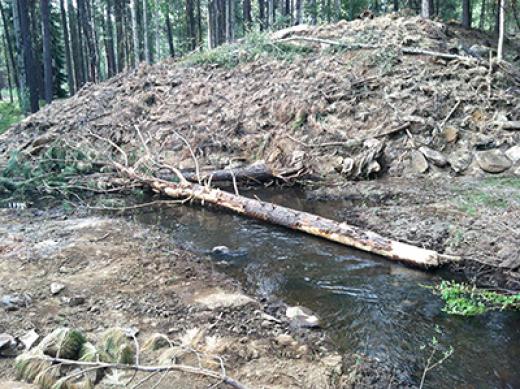Indian Ford Culvert Removal
Indian Ford Creek is a slice of the American West, gliding through the town of Sisters, Oregon, and filled with quaking aspen, beaver, and our local Columbia Basin redband trout (Onchorhychus mykiss gairdneri). Unfortunately, like other Western streams, it has a checkered past as this accessible stream was settled in the 1800s and the character of the stream has changed over time. Indian Ford, like other streams in the Deschutes Basin provided a critical water source in dry country, and it has a history of logging, diversions, heavy grazing, and road building, which has altered the habitat and fishery. But, similar to other trout streams in Central Oregon, it is gaining new life and going through restoration work which will reconnect its waters with trout and steelhead habitat downstream. Trout Unlimited and the Deschutes National Forest have targeted two culverts for removal to reconnect some of the quality habitat the stream does contain, and Orvis has stepped forward to help with the funding for this important drainage.
Indian Ford Creek is a tributary to Whychus Creek, which historically was an important steelhead spawning stream and connects Indian Ford with the Deschutes River. Indian Ford is an interesting perennial stream, which originates on private land from abundant springs at Black Butte Ranch, it then flows onto Forest Service land and back onto private land before meeting Whychus Creek. Indian Ford Creek contains two sensitive species, redband trout and a charismatic little snail -- the Indian Ford juga (Juga hemphilli). The stream is unique because of the many wetlands associated with the stream and the large aspen and willow stands along it. These conditions make excellent habitat for beavers and many other types of wildlife, which in turn can help create cool pools for trout and young steelhead. Although not in historical records, it is also possible Indian Ford Creek could have once supported steelhead and they will have a chance to recolonize the stream. Steelhead have been reintroduced to Whychus Creek with fry outplants since 2008 and the first adult was documented in May of 2013. It is possible they may use Indian Ford Creek in the future if the population increases over time. However, it wouldn’t have been possible though without the removal of the Indian Ford Mainline culvert, which has been blocking passage to cooler waters and outstanding spawning habitat upstream.
This Mainline culvert was a barrier to fish and other aqautic organisms, because the culvert is undersized and has a hydraulic jump at the inlet, but with the help from funding from Orvis the culvert has been removed. Additional funding has been provided by the Deschutes Collaborative Forest Project, which is stakeholder driven effort to restore the forest and watersheds in the region, with the intent to fix problem forest roads and culverts like this one. Removing this culvert provides access to 5.8 river miles of habitat upstream in Indian Ford Creek and tributaries. By removing the culvert and the road bed, fish and other aquatic life can once again move freely back and forth, able to once again find a cold water refuge where there is more flow and better habitat during summer months when flows are low.
The restoration project was led by the Forest Service road crew, and they removed the existing culvert and road fill to leave 15-20 feet of floodplain on either side of the stream channel. Side slopes have been tapered back, and native vegetation added to the new floodplain. Whole trees and woody debris have also been added to the side slopes to create important roughness for stream flow and cover for young fish. And finally, after removing the road bed from the channel, we made sure gravel was present to provide spawning habitat and not embedded in fine sediment in this stream location. All in all, this important western stream has been reconnected with steelhead and trout habitat downstream, providing key access to cooler habitat during the warm months of summer. With the help of partners and key funding, trout can once again thrive, and be caught in this important neighborhood stream.
Author Darek Staab
Support from Nate Dachtler from the Deschutes National Forest

